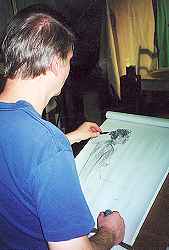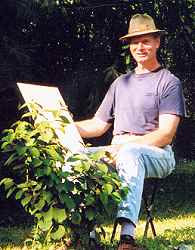Glimpse into the artist's working life as he works on location in the following creative activities:
Landscape
Still Life
Figure Studies
Sketchbook
He didn't set his students on the right path, he took them off it. He made them uneasy.
- Henri Matisse on his teacher, Gustave Moreau

|
Landscape With few exceptions, the artist paints entirely sur le motif, that is, "before the subject", in direct contact with the landscape. To capture it's essence, he seldom hesitates to withstand whatever the elements have to offer: summer heat, winter cold, wind, insects, and curious (and sometimes, irritating) onlookers, as well as days of perfect weather, are all a part of this experience. He usually prefers this direct, spontaneous manner of working outdoors, and the energy this imparts to the work, over the more introspective nature of studio landscapes. |

|
Still Life Still life painting continues as a source of inspiration for the artist, in which he controls lighting, composition, and design to a greater degree than his landscape work. A favorite technique involves painting a small group of objects outdoors in natural sunlight. |

|
Figure Studies Drawing and sketching the human form remains an important part of the artist's work. "The practice of drawing is fundamental to 'seeing' artistically. I would feel incomplete without it", he says. Even though the figure has never been the primary focus of his work, he attends weekly modeling sessions to improve his technique. Frequently, an undercurrent of sexuality is evident during these sessions. "That's usually fascinating, but it can be distracting at times", he reports. A side benefit is the opportunity to interact with other artists--a substitute for the usual workplace environment of most people, but at times missing from an artist's rather solitary life. |

|
Sketchbook An artist's sketchbook is a doodling pad, a testing ground for ideas where the mind can wander freely. Long considered that part of an artist's work not meant for public view, it's now seen as a fascinating window into the artist's private interactions with subject matter. When unsure about the merits of a composition, sketching it first can sometimes uncover potential problems, before starting to paint. "I prefer to paint the final result outdoors, rather than working in the studio from sketches made on-site," he says. "I once heard an artist say: 'When in doubt, draw!', and that's good advice for anyone interested in painting; besides, it can be very relaxing," says the artist. |